|
egy.com suggests following articles
|
|
Several of my articles on Garden City were plagiarized word for word by novelist MEKKAWI SAID (winner of the Egyptian State price for literature!!!!) and re-published under his own name in a three-part series in El-Masry El-Youm daily in September 2015. Cheers to our "talented" literature prize awardee. Your pain his gain !!!
|
EGY.COM - ZAMALEK
PALAIS TOUSSOUN
by Samir Raafat
Cairo Times, 14 September March 2000
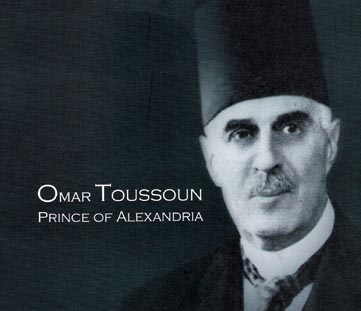

1930s photo of Palais Toussoun (courtesy Toussoun family)
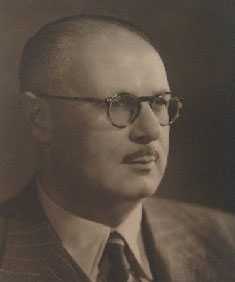
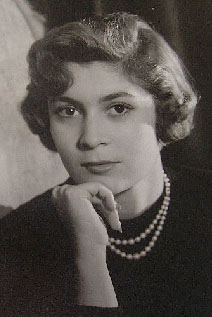
Princess Nawal Toussoun and husband Prince Saiid Omar Toussoun, last pre-1952 occupants of Palais Toussoun on Zamalek's Hassan Sabry Street (photos courtesy Kadria A. Zaki)
We drive by its large iron gates each day but hardly know its history. All we see is another inaccessible fiefdom belonging to some government ministry, a sumptuous place where platoons of civil servants enjoy coveted sinecures. I am referring to Palais Toussoun, No. 11-A Hassan Sabry Street (opposite the restoration-in-progress Dutch Embassy).
In the days when Sharia al-Gabalaya was renamed Hassan Sabry Pasha Street in homage of the late prime-minister by the same name, certain members of the Egyptian royal family were overcome with grief. If anyone deserved to have his name on the related street sign it was the highborn occupant of the neighborhood's grandest mansion, Prince Omar Toussoun.
A direct descendant of Viceroy Saiid Pasha who initiated the Suez Canal scheme, Prince Toussoun was the principle patron of Alexandria's academic, archeological and cultural institutions. His generosity towards civic organizations dealing with improvements of Egypt's summer capital had earned him the informal title of Amir el Iskandaria--Prince of Alexandria.
Why then was Toussoun by-passed by a commoner who, as head of the government, had not exceeded a year in office? And if any of the villas and mansions fronting the newly renamed Gabalaya Street were a criteria to go by, then most certainly Villa al-Shagartein (Two Trees; later replaced by Benetton Bldg. in 1980s) belonging to Hassan Sabry Pasha paled next to the imposing Palais Toussoun.
Perhaps the answer lies with an explanation put forward by a younger member of the Toussoun clan. The misnomer originated with King Farouk's perceived rancor against his more scholarly cousin. Moreover, Toussoun's popularity among the peasant class did little to endear him to the young monarch. The name Sharia Amir Toussoun was therefore relegated to a little used Zamalek side street (now, al-Sheik al-Masrafy). End of story!
Yet the designation 'Palais Toussoun' itself could be contested. A title and deed search will show that the palace did not belong to Prince Omar Toussoun but was instead the property of his wife, Princess Bahiga Hassan. True, the Toussouns ordinarily lived in Alexandria (their palace now the Broadcasting HQ in Bacos), but as court life filled out their trips to Cairo were becoming more frequent. And Shubra no longer being what it used to be, a new fashionable Cairo residence had become a necessity.
Independently wealthy, Princess Bahiga Hassan purchased Villa Lyons sometime during 1922-3. The house was then named after its first British owner H.G. Lyons, the sometime director of the Survey Department. Sometime before the purchase it had also been occupied by Belgian diplomat Charles de Royer.
Surrounded by 6300 square meters Palais Toussoun was considered prime Zamalek land at the time. The choice of location was no coincidence. The epic receptions given by her grandfather at the Gezira Palace (later, Marriott Hotel) during the Canal's 1869 opening celebrations had since propelled into urban history what had until then been regarded as some quaint hamlet perched on shifting mud-reefs. Indeed, the entire island had been a dependency of Khedive Ismail's summer palace.
It was also at the Gezira palace that Princess Bahiga's parents celebrated their nuptials and in all probability she may herself have been conceived in Zamalek.
Palais Toussoun's consists of three independent units. The main building or haramlik stands at the southern end of the park. This building underwent several exterior changes with embellishments added here and there giving it an oriental-Islamic flavor.
Whereas Princess Bahiga and her three children--Saiid, Hassan and Amina, along with a large retinue lived in the haramlik, Prince Omar held separate court in the salamlik---official quarters and daira-privy offices.
The salamlik was situated on the northern perimeter (today HQ of the Writer's Union) of the property. It was there that the younger Toussoun princes took their Arabic lessons with an Azharite Sheik.
Having survived her husband by three years Princess Bahiga deeded her Zamalek palace to her two grandsons Hussein and Hassan. By so doing she would invariably exclude all other Toussoun grandchildren born after her death in 1947. Would estate problems arise in the future? Not really, for as though pre-empting such an occurrence, the state in 1953 confiscated all properties belonging to the royal family. Henceforth Palais Toussoun and its dependencies became state property.
The palace's last pre-1953 occupant were Prince Saiid Toussoun and his second wife the beautiful Nawal A. Zaki. The fall of the monarchy would ultimately condemn them to a life of luxurious exile between Avenue General Manoury, Paris and their large haras--country estate outside Deauville, France.
The first post-1953 occupant of Toussoun Palace was officer Anwar al-Sadat. As Chairman of the newly established Islamic Interchange Conference he moved into the palace-turned-offices in the summer of 1954. His awe with the opulent surroundings notwithstanding, Egypt's future president was especially interested in Prince Toussoun's vintage collection of radio transmitters. In deference to his new duties and as purposefully underscored in al-Ahram's 25 August front page, Sadat's first directive regarding Palais Toussoun was the conversion of Prince Saiid's well-appointed bar into a prayer hall.
Since then, a succession of government ministries moved in and out of Palais Toussoun last of which was RITSEC, the incumbent government's Information Technology arm. And if the present occupant is a reflection of changing times Prince Toussoun's now-antique transmitters have been replaced by satellite technology and high-speed computers.
As Egypt strives to reconcile itself with its recent past, a grandson of Prince Omar Toussoun born after 1947, has filed a civil lawsuit against the state reclaiming his Zamalek birthright.
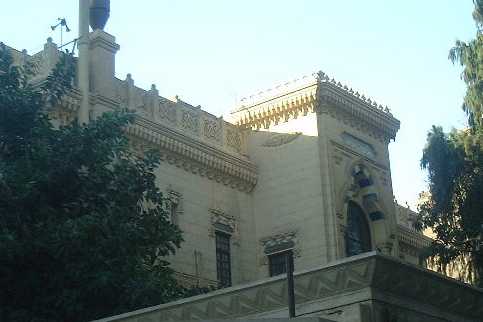
back view of Palais Toussoun
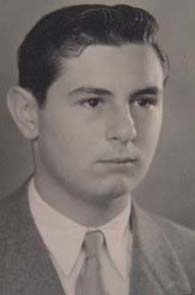
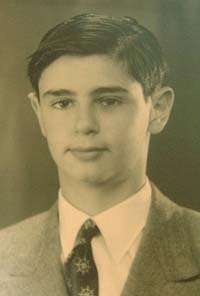
Prince Saiid's sons Hussein and Hassan from his first wife Mahveche Chirine
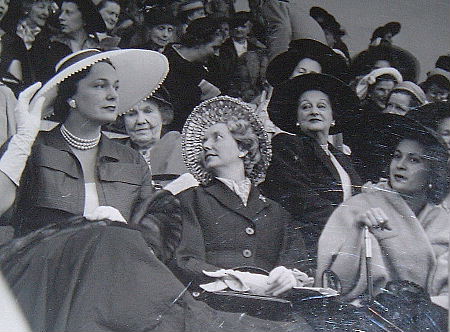
Princess Nawal Toussoun (far right) with the Begum Aga Khan (far left) and M. Guinness in middle
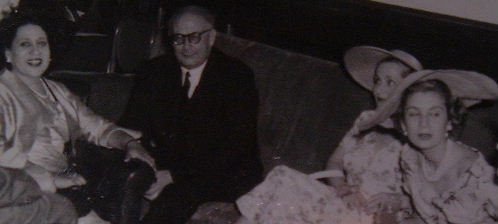
The Toussouns with Gertie Wissa (above photos courtesy Kadria A. Zaki)
Notes:
- On 3 September 1955, Palais Toussoun in Bacos, Alexandria, was the scene of a historic auction where the prince's valubales and objets d'art were put on the block.
Reader's Comments
|
From: Mohamed El Shafie <mohamed.elshafie@oracle.com>
Subject: PALAIS TOUSSOUN
Date: Mon, 11 Sep 2000 15:31:43 -0400
I worked for IDSC which is the parent for RITSEC in 1991. So, I had the chance to go around and inside this wonderful palace. I really felt bad to see how much they destroyed the walls so that they could transfer the rooms into to offices. I hope one day they will renovate it so that it become s a museum like Prince Amr Ibrahim's nearby Palace. But speaking about Toussoun family, I have few questions:
1. Was Toussoun a son for Saiid Pasha, or was Toussoun the direct son of Mohamed Ali Pasha?
2. I read once in Mosamaet ElGeab Magazine dated 1947-48 that one of Toussouns was killed in car crash in France while driving back from his summer holiday. I think he was the husband of Princess Fatima Toussoun whom King Farouq loved and tried to marry but she ran away and got married to a Brazilian prince.
3. Is Nawal Toussoun the famous painter now living in Europe?
4. Who was the father for Princess Bahiga Hassan?
Shall we wait for an article about Sultana Malak's palace in Arouba St.? We need to know more about it.
Reply:

Prince Hassan Ismail (seated) with prime minister Mustafa Fahmy Pasha (photo courtesy Kadria A. Zaki)
Yes, it would be a good idea if Palais Toussoun could be turned into an art museum, or at least restored to its original state for by itself the palace did not lack museum pieces: Louix XV and Louis XVI furniture, a priceless collection of Boules pieces plus a collection of portraits of various Mohammed Ali descendants. This, apart from the rare collections library. In answer to your questions:
1. The existing Toussoun branch of the Mohammed Ali family are descendants from Saiid Pasha through his son Mohammed Toussoun who died a brutal death during the Sudan campaign.
2. Prince Hassan Omar Toussoun died in a car crash in Beaulieu-sur-Mer on 15 November 1946 while being driven to Marseille to catch the ship to Alexandria. His former wife Fatma Chirine (died 1990 in Brazil) married Prince Joao de Braganza from whom she had a son who lives in Rio de Janeiro (see pictures below).
3. Nawal "Nannou" Toussoun born Nawal Aziz Zaki -- a grand-niece of Prime Minister Moustafa Fahmy Pasha and junior cousin of Safeya Hanem--Madame Saad Zaghloul Pasha. (See picture in article The Saga of the Aga
4. Princess Bahiga was a daughter of Prince Hassan, son of Khedive Ismail.
|
Email your thoughts to egy.com
© Copyright Samir Raafat
Any commercial use of the data and/or content is prohibited
reproduction of photos from this website strictly forbidden
touts droits reserves
